|
"Solidifying
Peace in Burundi"
Project
Report
September
2005 - June 1, 2006
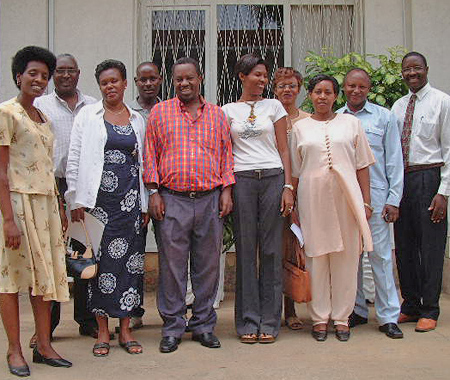
© Jan
Oberg TFF 2006
Members of the TFF
Amahoro Coalition in Burundi, Sept 2005
Lund, Sweden - June 2,
2006
This is the report of the foundation's
activities in Burundi on a one-year grant of Swedish
kronor 304 000 or US$ 42 000 from Sweden's
Folke
Bernadotte Academy.
TFF and its partners in Burundi want
to thank the Academy for its generous support.
The foundation's work in Burundi since
1999 has been financed by donations made to TFF by
citizens around the world. We thank every one of them
too.
TFF team members contributed to this
report. You can read more about Burundi's peace process
and why it deserves to be support by the international
community here.
Jan Oberg, project
responsible
TFF
director
Activities
and results up till June 2006
This report has two parts: A)
Description of concrete activities, the project
development and TFF's missions to Burundi, and B)
Evaluation, summary and future activities.
The Amahoro Coalition is central in
this report. It consist at the moment of the following 13
Burundian NGOs:
• African Public Radio - Radio
Publique Africaine (RPA)
• Association des Femmes
Juristes du Burundi (AFJ)
• Association Pour La Paix et
les Droit de l'Homme (APDH)
• Compagnie des Apôtres
de la Paix (CAP)
• Centre d'Alerte et de
Prévention des Conflits (CENAP)
• Maison de la Presse du
Burundi - House of the Press
• Observatoire de l'Action
Gouvernementale (OAG)
• Trauma Healing and
Reconciliation Services (THARS)
• Universite Lumiere de
Bujumbura
• Ligue Burundaise des Droit
de l'Homme - ITEKA
• Syndicat des Travailleurs de
l'Enseignement du Burundi - The Teachers' Union of
Burundi (STEB)
• Forum pour le Renforcement
de la Societe Civile (FORSC) - with 60 member
NGOs
• Genies en Herbes - Youth
organization, leadership and excellence.
Their common project is to
establish the Amahoro
Open Centre which is
described in details at:
.
PART
A
Mission
1 - October 14-24, 2005
36 meetings with members of the
Amahoro Coalition, a variety of staff of the
UN
mission (ONUB) including
Head of Mission, Mme MacAskie, ambassadors and others
from potential donor countries, with various individuals
and intellectuals in the country, a presidential adviser,
other international NGOs.
The main purpose was to move
forward the single project chosen by the Coalition, i.e.
the establishment of the
Amahoro Open Centre in
Bujumbura. This was done by working closely with the
Coalition members and by presenting the project and build
goodwill for it with everybody else.
The project description and a
series of ideas were discussed and several revisions made
during the days, ending with a meeting before departure
with the Coalition members at which the project was
endorsed by all (minutes available upon
request).
It goes without saying that our
Coalition members and others expressed happiness that the
Folke Bernadotte Academy had granted TFF the funds that
enables it to support the Coalition on a regular,
continued basis for 12 months. This considerably
increased their belief in the project as such and their
willingness to invest time and energy in it.
The only negative result of this
mission, in the midst of this progress, was that one of
the two TFF Associates, Dr. Sururu Adolphe, went inactive
and out of communication, probably due to too many other
commitments; we simply don't know. Fortunately,
Chantal
Mutamuriza - the other TFF Associate in
Burundi - was willing and
able to fulfil both roles and has, thus, served as
Project Coordinator in close, almost daily, contact with
me. To both the Amahoro Coalition and TFF this has worked
excellently; she is diligent, highly respected,
intellectually curious, well versed on running
organizational matters, socially competent and speaks the
three necessary languages (Kirundi, French and English)
fluently.
During this mission one more
organization, FORSC, became a member of the Coalition and
signed the Memorandum
of Understanding.
In summary, this mission solidified
the project, gave it a single focus and set the process
of realizing it on track.
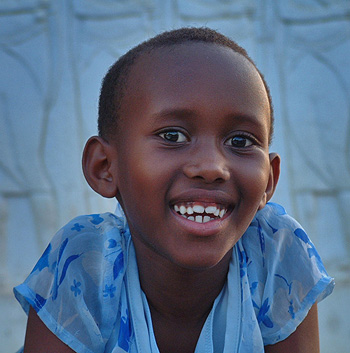
©
Jan Oberg TFF 2006
The Amahoro
Coalition & TFF work for her
generation
Mission
2 - January 17-29, 2006
Main purpose was of this mission
was that TFF board member Else
Hammerich and
Jan
Oberg gave a three days
intensive training course on a broad variety of peace
issues such as definitions of peace,
conflict-understanding, groups dynamics, reconciliation
and forgiveness for 16 members from the Coalition NGOs (2
organisations had not sent participants due to practical
circumstances). The participants, roughly 50/50 women and
men, had been selected by the leaders of the Coalition
NGOs as those to whom future Amahoro matters will be
delegated.
The idea of the Amahoro Centre was
a through theme to which the more theoretical issues were
linked in group work and plenary discussions. Thus, the
course indirectly served as a preparation for the
co-operation among all in setting up the
Centre.
(Minutes of the discussion and
issues raised is available upon request).
It soon turned out that the
top-leaders of the Coalition NGOs had done very little to
spread the news about the Coalition and the idea of the
Centre to their staff, so we had to focus a lot on issues
of communication and co-ordination. To facilitate this
much more effectively and democratically in the future,
each member NGO has now appointed a "Focal Point" who is
responsible for all communication inside his/her
organisation, with Chantal and I and with other Coalition
members pertaining to the Centre; an e-mail lists have
been set up. Several of the Focal Points are level-two in
the organisation; this has already proved to be a much
better solution than relying on the top-leaders most of
whom are overburdened already.
In addition, we had 20 meetings
mainly at embassies and the UN to present the Amahoro
Open Centre idea and clarify when they will be able to
process the Coalition's funding proposal. . Hammerich had
some alone to get acquainted with Burundi and the
Coalition leaders (this was her first visit). We spend
time with Coalition members who have formed a committee
to work out a budget for the establishment of the Open
Centre, the first year of operation and activities
including a series of training courses for people from
the regions.
We met with UNOB and the
UNDP
and the latter's country director Antonius Broek kindly
offered to arrange a donors' meeting at our next visit at
which the Coalition members and TFF could present the
Amahoro Open Centre project to various countries and UNDP
staff. As a quid pro quo he asked Jan to give a short
lecture on peace and conflict theory internally for UNDP
staff. (See next mission).
We received exclusively positive
reactions to the Amahoro Centre idea during our meetings
with people at the embassies of France, Belgium, Holland,
DFID (England) etc. Without exception they encouraged us
to submit the final proposal with a budget.
During this visit, Jan also planned
the forthcoming one-week course in peace and conflict
studies with the rector of the Lumiere
University.
The mission ended with a gathering
of the Coalition where reports were given by Else and
Jan, problems solved, co-ordination improved and decision
made as to the next steps (minutes available upon
request).
Mission
3 - February 13-26, 2006
Main purpose of this mission was
that Jan Oberg gave the mentioned introductory course in
peace and conflict studies, the first-ever in the
country, at the mentioned private university, a member of
the Amahoro Coalition.
While there Chantal and he squeezed
in as many meetings they could, particularly with donors,
private business and banks - all appreciating the idea of
the Centre and willing to later take a look at the
project plan and budget with a view to make donations in
cash or kind. One of them, the Indian owner of a
pharmaceutical company liked the idea due to his
admiration for Gandhi, invited Jan to give a lecture to
the Bujumbura Rotary Club of which he is the President
and a main donor himself. No doubt, he will do something
for the Centre, and this is an example how we build
goodwill with many people of rather different walks of
life.
For a second time, we met Mme
MacAskie, head of mission of the UN mission and about to
leave the mission. Her and other UNOB staff's interest in
the Coalition and the Centre has been quite touching.
Undoubtedly, the ONUB mission belongs to the - many -
succesful UN mission around the world that are seldom
given the global media coverage they deserve.
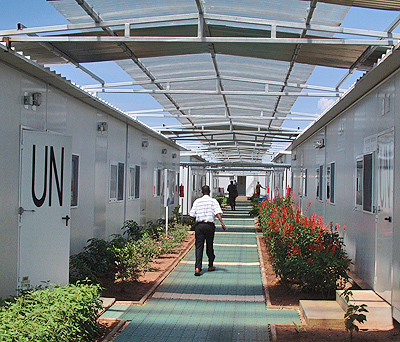
©
Jan Oberg TFF 2006
From the charming
container compound of the UN in
Bujumbura
She advised us to ensure that the project also has the
support of the Burundian government. So we handed in
requests for meetings with the President, a
vice-President, the Speaker of Parliament and the
ministers of the Interior and Foreign Affairs. The
Speaker Mme Immaculée Nahayo and the Foreign
Minister, Mme Antoinette Batumubwira went through
immediately.
They both expressed their sincere
gratitude to us, to the Coalition and to Sweden for
having taken it upon us to do this in support of the
peace process of their country. The Minister of Foreign
Affairs emphasised that the Centre should reach out to
the 17 regions from Day One and should also seek
co-operation with similar Centres in the Great Lakes
region. These points are now built into the project
description. With her we also discussed TFF's future role
as goodwill ambassadors, a concept she liked, and how we
could use TFF Associates in the media to help promote
Burundi's peace process abroad as well as perhaps give
courses for Ministry staff.
The Speaker of the Parliament
wanted us to see the Head of the Commission on Youth,
Culture and Sports and discuss also various trainings
that could be done with MPs.
At the Maison de la Presse, a
member of our Coalition, the request was made for TFF to
help train media people from the Great Lakes region in a
triangular effort between media organisations there, the
Panos Paris Institute and TFF in Sweden. The ball is with
now the Maison and Panos.
Overwhelmingly, 130 first-year
students (hutus, tutsis, and others) had signed up for
the 5 days intensive course at the beautiful campus in
the hills overlooking Bujumbura and Lake Tanganyika.
Teaching every day from 8.00-12.00 and 14.30-17.30.
Conditions: great curiosity and participation, but no
books, no photocopier, only three days a week with
electricity, no access to Internet, no library.
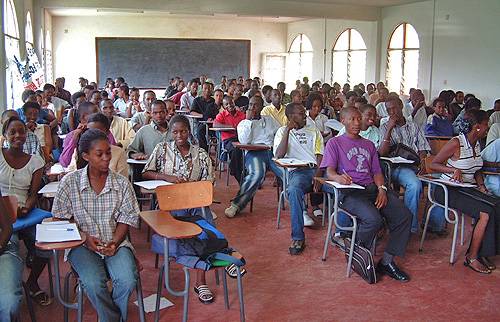
©
Jan Oberg TFF 2006
Students in the
peace studies class at the Lumiere
University
Experienced in teaching in
different cultures and under rather varied circumstances,
Oberg felt that this was among the most rewarding and
moving he has ever done. For instance, students managed
to have serious group work discussing what had happened
in the country, analysing it by the tools and concepts
imparted to them, presenting it all and discussing
criss-cross the room. This would have been unthinkable
just a couple of years ago. These students gave Jan even
more hope that peace is possible in Burundi.
The students told rector Gregoire
Njejimana that all the 1800 students ought to have an
opportunity to study peace, and he urges us to ask the
Bernadotte Academy to support a program that would permit
at least some more courses to take place in the future.
Important in itself to teach young
Burundians, there is no doubt that the most talented of
them could well be future leaders of civil society and
government in this country. They were also informed about
the Amahoro Coalition and Open Centre and since about 70
of them handed in their e-mails we will be able to be in
contact. Many of them expressed their interest in joining
a Coalition member NGO and work as volunteers to build
the Amahoro Centre.
The UNDP donors' meeting went very
well. Coalition members were present together with aid
agencies and ambassadors. We presented the Coalition and
the Centre idea and Mr. Broek spoke strongly in favour of
it, ending the meeting by looking at the assembled people
saying, "This is certainly something we should all
support." UNDP has appointed three Focal Points to
interact with us. I gave the UNDP staff a mini lecture
and it was decided that we should work out a plan for
more teaching and training with the UNDP and possibly
other UN bodies who support the Coalition.
More meeting were held with
potential donors and supporters, among them the
Ambassador of South Africa that has a particularly
important role in Burundi's peace process.
Again, on the final day, members of
the Coalition met. Chantal and Jan reported what had been
achieved. Various working groups were established to
finalise the project description and edit it into a
funding proposal; revision of the budget will be done.
A Committee was also set up to deal
with various options on how to transform the present lose
Coalition network into an operative body once the funding
has been obtained and the Centre becomes an
administrative, economic and legal body. The general
sense is that it should be as formal as required by
donors and laws and as informal and flexible as possible
to remain dynamic and to not become a hierarchy of power.
(Minutes available upon request).
Mission
4 - May 22 - June 1, 2006
The purposes of this mission was
to:
a) follow-up on the grant proposals
submitted to various countries and the UNDP,
b) submit it to three new (China,
Russia and US DAI),
c) visit local antennas of
Coalition NGOs in the second richest province Gitega and
in the second poorest in Ruyigi,
d) do fact-finding interviews with
local governors to understand the provincial situation
better,
e) visit other civil society
organisations that the Amahoro Coalition and Centre shall
reach out and cooperate with plus, f) meet with selected
Coalition members in Bujumbura,
g) present the Amahoro Coalition
and Centre to the government (in this case, the Minister
of Foreign Affairs and the country's President Pierre
Nkurunziza) as well as
h) discuss the project with UNDP
staff members.
Both the President and Minister of
Foreign Affairs have stressed - strongly - that the
Amahoro Open Centre and its activities predominantly
benefit the provinces rather the people in Bujumbura, it
was particularly important for the project coordinator
and Jan to this time give priority to travels and
meetings in the provinces. And indeed the differences
between life there and in Bujumbura are striking.
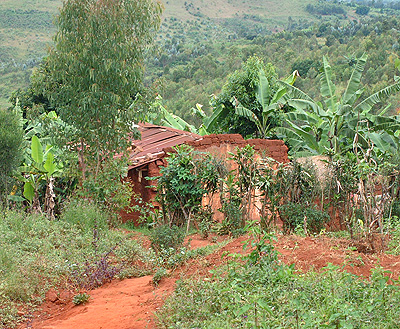
©
Jan Oberg TFF 2006
Typical countryside
view of Burundi and its red soil
We met with two "new" organizations
that are a) without office in Bujumbura and b) are very
focussed on peace and reconciliation and c) have produced
results over the years that are admired everywhere -
namely "Maggy" Barankitze's Maison Shalom in Ruyigi and
Levy Ndikumana's Mi-Parec in Gitega. They are likely to
join the Amahoro Coalition in the near future and
cooperation about local courses has already been
discussed.
During the visit a bank account was
set up in the Interbank Burundi in order to ensure that
Coalition activities as well as project coordination can
continue until a) funds are made available for the Centre
by the international donor community and b) TFF may
obtain funds for one more year's activities. Cash can be
withdrawn from this account only with Jan Oberg's written
authorization (by fax/email). The account can be used for
things like a photocopier, printing of pamphlets and for
the launching of a Coalition/Centre homepage.
A sub-group of the Amahoro
Coalition is now working on a couple of proposals for
statutes, coordination and decision-making for the
Centre, so that the Centre will be operating both
democratically and efficiently from the moment funds come
through for the establishment of the Centre.
In this way continuity is secured
for in the period between this first year of operation
and the next. Given the delicate peace process of the
country and the fact that TFF is not registered as a
foreign NGO in Burundi, it is extremely important for the
future momentum that the Amahoro Coalition and Centre has
the full support from the Minister of Foreign Affairs (2
meetings), the Speaker of the Parliament and with the
President who endorsed it fully and ended a
longer-than-usual meeting by saying that he would pray
for the Centre because of its possible role in securing
peace in the country.
This is what has been achieved up
till June 1, 2006.
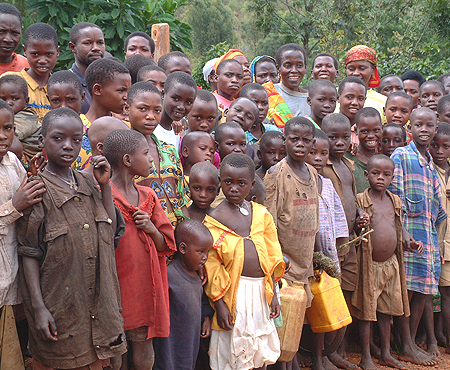
©
Jan Oberg TFF 2006
Children's rights
and the human right to peace...
Part
B
Summary
of activities and other matters
1.
Goal achievements
The project has been rooted well in
Bujumbura, we work with some of the best, most
experienced and respected NGOs. TFF has conducted a
successful screening of Coalition members, facilitated
dialogues, meetings with democratic decision-making. An
e-mail network has been set up among them, we have
conducted courses and seminars; the Coalition has
brainstormed on choosing a single integrated project and
come up with the idea of the Amahoro Open Centre
described on our Burundi
Forum here.
Most important for the future, a
solid project proposal with a budget has been developed
by the organizations themselves. This is undoubtedly
their commitment to the process, to building peace in
Burundi (beyond their own individual projects and
activities).
In TFF's funding proposal to the
Bernadotte Academy we stated three main goals. We
believed we have advanced them all.
2.
The Amahoro Coalition as partners and soon-to-be
carriers
The Coalition partners are very
important and wide-ranging for the Burundian peace
process. For instance, League Iteka is the largest and
internationally respected human rights organizations.
FORSC has over 60 member NGOs. STEB, one of two teachers'
associations, have 14.000 members. The RPA Radio is
either the most or second-most listened-to station in the
country. The Light University is a dynamic new private
university with 1700 students. APDH is a country-wide
youth organization. OAG and CENAP are leading research
and think tanks on socio-political affairs. THARS is the
leading organization for trauma-healing and
reconciliation.
What the Coalition and the future
Amahoro Open Centre will do will, literally, have an
impact on tens of thousands of Burundian citizens.
The Coalition is now a quite
cohesive group with committed people who see a purpose
and feel that synergy is possible. We have anchored the
project with the donor community and many interested
parties in Bujumbura.
However, it should also be stated
that in a country such as Burundi, NGOs are fragile in a
serious of ways. Funds, electricity, technical
competence, a culture of cooperation and coordination and
strong centralization to the capital are structural
factors that any foreigner will have to deal with. In
particular, until the international donor community
decides to donate at least some of the desired means for
a place to be found and concrete activities to start, the
Amahoro Coalition members will hardly give the Open
Centre first priority among their many activities.
And by all feedback TFF has
received, there is no doubt that they feel the foundation
should remain active on the spot and do training,
dissemination and practical work together with them until
the Centre is a reality and operates on a daily basis. To
give just one example, here is what the leader of THARS,
David Niyonzima, wrote in an email May 30:
"Dear Jan, It was so good
to have a chat with you and Chantal at the Gitega
Tamotel the other day. Thank you for allowing me to
come over and spend sometime even though it was so
late. I am now in the USA attending a course on
Perfromance Measurement of Effectiveness of Nonprofit
Organizations, at Harvard Business School. I hope that
what I will learn could also be useful in our Amahoro
Coalition.. Thank you again for your heart for
Burundi. We are so encouraged by your support and
care. David."
3.
The role of women
One criterion for selecting the
NGOs to the Coalition was that they expressed a serious
commitment to reach out and include women, children and
youth. They all do and several of them either have
leaders or deputies who are women. The majority of those
who participated in our training course were women. Our
project coordinator is a woman.
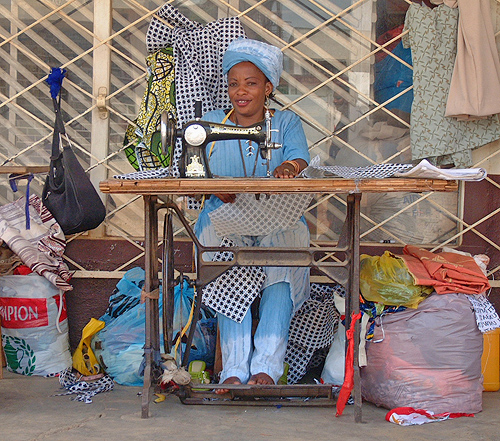
©
Jan Oberg TFF 2006
Sewing a dress in
the street of Bujumbura
Indeed, the newly elected government has 36% women
ministers, including the important post as Foreign
Minister; and the role of women is constantly emphasized
by both parliamentarians and the President. At the same
time, we are keenly aware that there is still a male bias
in the daily practical work and we will focus future
training activities even more on women, children and
youth, i.e. on teachers and human rights workers in
particular who work to reduce violence against women
throughout the Burundian society.
4.
Information and dissemination
A stated goal was also to provide
information. Much of what has been produced and achieved,
including the revised Amahoro Open Centre proposal, has
been posted on TFF's website. We have also planned a
series of articles about Burundi's peace process and the
situation of the country, for the international press.
TFF is now accepted as informal goodwill ambassador for
Burundi's peace process.
Jean-Marie Vianney Kavumbagu, a
member of the Amahoro Coalition, will design and edit a
homepage for the Coalition and its Centre over the
summer; he is President of League
Iteka and webmaster for its
homepage as well as for LDGL
Human Rights regional
network. The new site will be interacting with
TFF's
Burundi Forum.
This will help spread the message
also beyond the borders of Burundi. In addition it will
permit the Coalition members to upload articles, press
releases, their papers and reports, etc. in a simple way
in that section. A pamphlet and other materials will also
be produced to assist also in fundraising among Burundian
citizens for the Centre.
TFF board member Annette
Carlsson, an experienced TV
journalist, is planning to produce a documentary for the
Swedish Television and possibly other outlets. It will
focus on Burundi's peace process and on the setting up of
the Amahoro Centre, thus emphasizing the civil society
empowerment dimension. The project is already described
and a photographer identified. Budget work and
fund-raising will be done over the summer.
During the last mission it was
agreed with the Minister of Foreign Affairs herself that
TFF will submit a paper that outlines some elements of an
international communication strategy for Burundi's peace
process. She also emphasized that anything we could do to
support the training of journalists would be highly
appreciated. Proposals for that will be developed over
the summer with other TFF Associates and our Coalition's
media expertise and other experts.
The above-mentioned film project by
Carlsson may serve as one important tool to reach a wider
audience internationally and was high praised by the
Minister of Foreign Affairs.
It should be mentioned also that
the present Burundian government has revived, in its
official program, the plan to set up a state institute
for peace and democracy. TFF developed the concept for
the government in 2000 that was however never
implemented. This institute was discussed with the
President who expressed a wish to see the proposal
developed by TFF at the time. It has been sent to
him.
Finally, Jan Oberg has produced a
40-page analysis, to by the academic Conflict
& Communication Online
journal about the international media coverage of Burundi
and its peace process. It deals also with war versus
peace journalism and, towards the end, outlines a few
elements of an internatinal media strategy for the
country. (To be published later in 2006).
5.
The next 12-24 months
The total estimated budget for the
Amahoro Centre is around 160.000 Euros. The project
description and that budget have been submitted to the
embassies/representatives of England, Holland, Belgium,
South Africa, China, Russia, US DAI, Switzerland, UNDP,
ONUB a.o.
We are in the process of seeking
support from the Swedish and Danish development agencies.
We have begun to approach private business in Bujumbura
and ask for their support in money or kind.
This budget includes a) the
establishment and renovation of the facilities,
equipment, machinery etc; b) operating costs including
salaries for Year 1; and c) costs for a series of
training of trainers from the provinces who can root the
Amahoro idea there. This is of course a dream or a vision
with price tags, and the Centre can start operations with
less than the full sum. A series of income-generating
activities are mentioned in the proposal as all Coalition
members know that no donor will finance the Centre for
more than 1-3 years at maximum. So although we are
confident that we will get a substantial support from the
international donor community, there is still a long way
to go to realize the dream.
In a non-prioritised order here are
the things that should be done in the next 1-2 years to
see the Amahoro Coalition and Centre develop
strongly:
•
Approaching the Danish and Swedish governments/aid
agencies and ask for their support of the Amahoro
Centre.
•
Reviewing the various options for the administrative
establishment of the Centre, including writing the
minimum statutes, setting up a coordinating board and
opening a bank account.
•
Trying to meet the
stated needs of the Coalition members for more
training in a broad variety of issues, the given three
days training certainly not enough. We have an ongoing
discussion with Else Hammerich's Centre for Conflict
Resolution in Copenhagen about joining forces for
that. Back in time the Coalition members had a
brain-storm on what themes they thought they needed
and more came up during our three days training in
January. We should see it as training trainers so they
themselves can do a series of courses with people from
the provinces.
•
Handing in the funding proposal with budget for the
Amahoro Centre as the deadline of various donors
approach. The first is with DFID on April 1, 2006, the
last we know of to the French Embassy by September or
October 2006.
•
Hopefully obtaining enough funds to begin finding the
house/rooms to rent and start renovating and organise
the Centre's premises with its various activities.
During this start up phase, TFF will have to
permanently present over several weeks and a lot of
administrative decisions will have to be
made.
•
Further building of goodwill nationally - including an
information and media campaign throughout society so
we get volunteers and all interested to join
forces.
•
Further fund-raising among Burundian business and
wealthy people plus getting Burundian artists,
musicians and others interested and contribute their
art and music etc to the Centre when it is
there.
•
Work to do other courses, such as with media people,
should the Maison de la Press-Panos Paris project come
through with our participation.
•
Various possible training activities with UNDP, ONUB -
not the least in the countryside (as a quid pro quo
for their support in cash or kind to the
Centre).
•
Future university teaching and courses.
•
Supporting in various ways the establishment of (a)
similar Amahoro Centre(s) outside
Bujumbura.
•
Assist the government in setting up a peace
institute.
•
Assist the government in developing and international
information strategy for the country's peace process.
Get
free articles &
updates
©
TFF & the author 2006

Tell a friend about this article
Send to:
From:
Message and your name
|